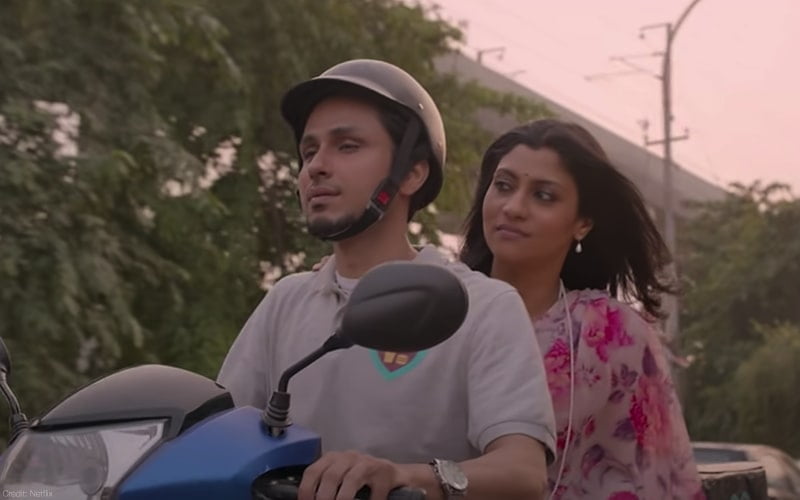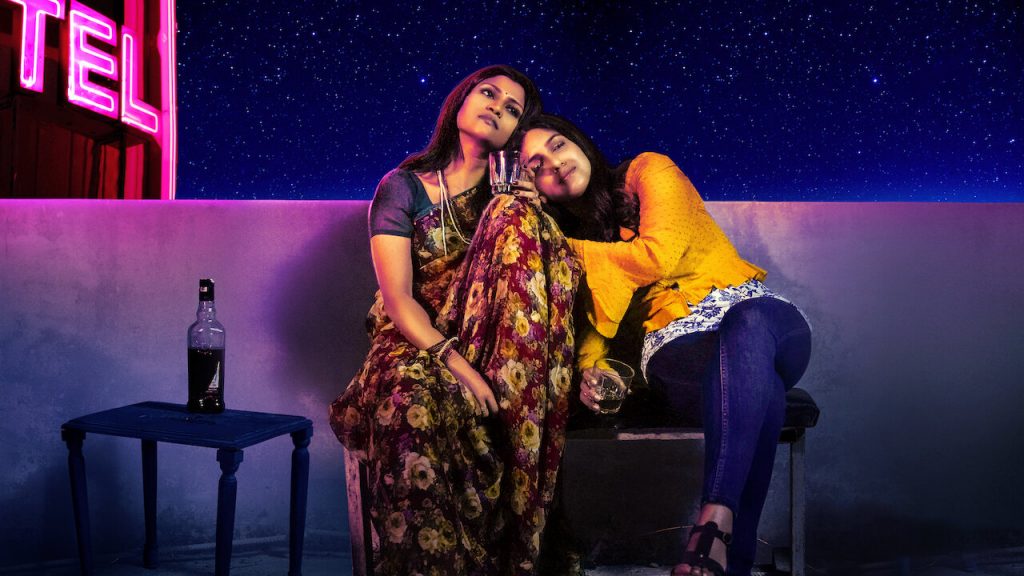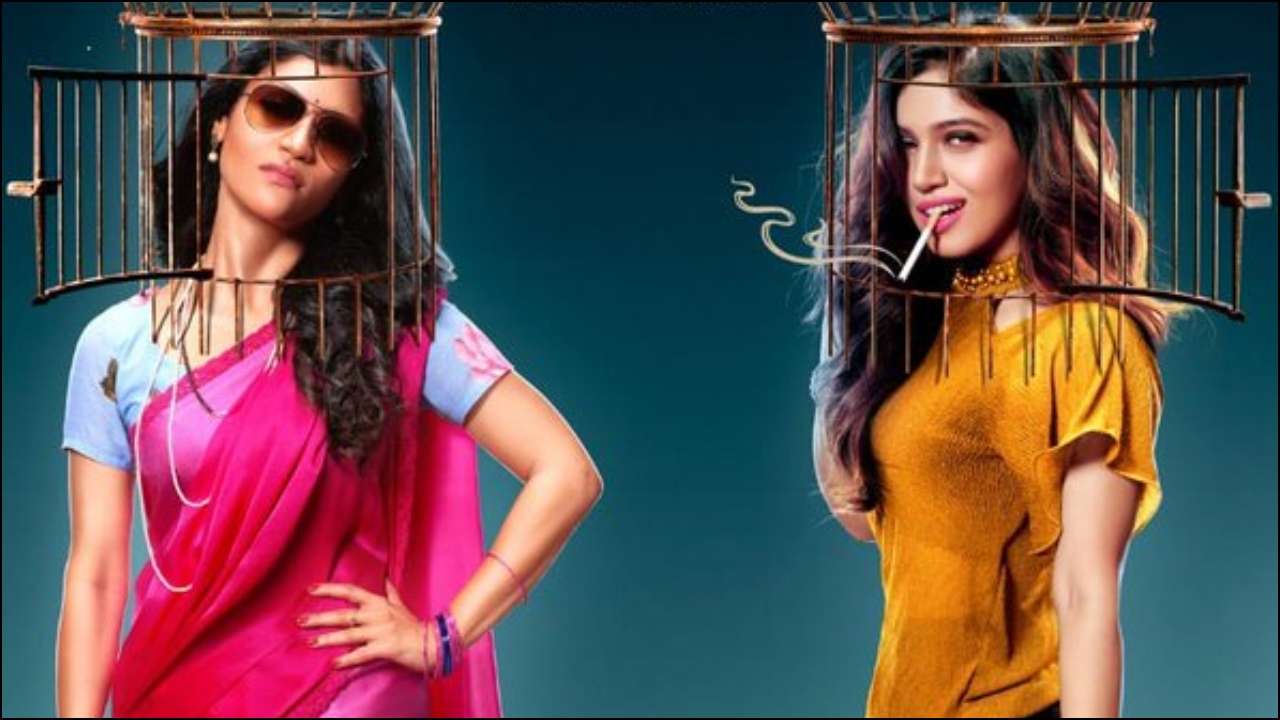This article contains spoilers.
Dolly Kitty Aur Woh Chamakte Sitare is straight out of Alankrita Shrivastava’s repertoire of feminist films that attempts to hit patriarchy in the guts, but is lost in its own crowd of issues. Dotted with themes surrounding expressions of desire, rough sex, slut shaming, sexual harassment, gender stereotyping, intersectionality of caste, class and religion among others, it highlights the misogynistic vices woven into the social fabric of Indian society. Interestingly, it also addresses a theme that has rarely found a place for itself in Indian cinema—queer childhoods.
The film revolves around two working class, backward caste sisters, Dolly (Konkona Sen Sharma) and Kaajal (Bhumi Pednekar) and their haphazard journey towards attaining freedom from the societal cuffs that bind them. Dolly, a government employee, trapped in a loveless marriage, and the mother of two kids, lives in Greater Noida with her family, estranged from her mother who had stepped outside the bonds of marriage, pativrata and motherhood to live a life of her own with another man.
Desire and Destitutes
Kaajal is a 20 something-year-old girl and Dolly’s cousin, who is in search of a job in the city and is preyed on by Dolly’s lecherous husband. Dolly’s husband Amit’s (Amir Bashir) abusive behavior towards her compels her to move out of her sister’s house into a group home for surrogates. While Dolly navigates the dormancy and awakening of her sexuality as a result of her desirous feelings towards a food delivery boy, Osman Ansari (Amol Parashar), Kaajal steps into the world of a romance dating app that requires her to ‘speak romantically’ to her lonely male callers, under the name of Kitty.
Dolly Kitty Aur Woh Chamakte Sitare is straight out of Alankrita Shrivastava’s repertoire of feminist films that attempts to hit patriarchy in the guts. Dotted with themes surrounding expressions of desire, rough sex, slut shaming, sexual harassment, gender stereotyping, intersectionality of caste, class and religion among others, it highlights the misogynistic vices woven into the social fabric of Indian society.
While Dolly balances her desire for Osman with a son who is ‘not boy enough’, Kaajal struggles to separate desire from work, when she falls head over heels in love with a client Pradeep/Chhatrasaar Singh (Vikrant Massey) who ultimately exploits her for sex. Both Dolly and Kaajal, belonging to a backward caste group, struggle with the challenge of overcoming the discrimination that accompanies their caste as well as their gender identities. While Shrivastava has attempted to discuss many such progressive feminist ideas in Dolly Kitty Aur Woh Chamakte Sitare, this issue, much like many others that I’ll be talking about, has failed to develop any further and easily can be seen as a tokenistic trope.

In their respective journeys of attaining independence, the two women are constantly bridled with dilemmas around ‘duty’ and ‘desire’. Kaajal is repeatedly slut-shamed by her sister because of her work and Dolly is called ‘frigid’ by her husband as she does not harbour any sexual feelings for him due to a lack of desire, resulting in a lack of a thriving sex life. Additionally, ideas of virginity, “wifely duties” (a euphemism for satisfying the husband in bed) and incessant eve-teasing are intertwined in a manner that seeks to bring to light the everyday struggles of women and the control that the patriarchal discourse attempts to exercise on their bodies.
A Crowd Of Issues Executed Poorly
The film also addresses communalism, shrouded in acts of moral policing that eerily bears semblance to the current functioning of the patriarchal Indian state, bringing from real life to reel life the Hindutva hooliganism propagated by the Bajrang Dal. The innate communalism also manifested itself in the way the two Muslim characters Osman and Shazia (Kubbra Sait) were treated in the film—their struggles with their intersecting identities of religion and gender (in Shazia’s case) were simply mentioned in passing and were far from being elaborated upon, where in the end both these characters are suddenly killed off in a communal strife for the preservation of “Indian culture.”
Interestingly, one of the most ridiculous renditions in Dolly Kitty Aur Woh Chamakte Sitare was that of a seemingly radical art piece—a larger than life modern representation of a vagina/yoni as a symbol of female empowerment and pleasure by an elite intellectual at a setting that was more Wasseypur than Lutyens Delhi. It was as peculiar to see a piece of art, such as this one, outside of their ‘elite spaces’ that attract higher class intellectual crowds, just as it is to see a fish out of water.

The juxtaposition of DJ Gujjar’s Punjabi ballad in the background with that of the monster size vagina was one that evoked a sense of oddity as the artsy intellectuals of Delhi don’t choose such spaces, that have people from middle/lower middle class backgrounds, for displaying elite-art steeped in controversy. Even in several ‘elite’ circles, this piece would have induced a sense of discomfort in many, so it’s quite surreal to think that in a not-so-elite Greater Noida space, it wouldn’t be a massive bone of contention that ultimately led to violence.
Also read: Film Review: Rajnigandha – A Woman’s Narrative Or Politics Of Appeasement?
While most of these themes of sexism, misogyny, class-caste hierarchy, communalism and whatnot, have been touched upon in Dolly Kitty Aur Woh Chamakte Sitare, none of them have been fully addressed enough to be rescued from the grey area of ambiguity. However, the one theme that stood out for me was that of queer childhoods.
In addition to this, while the film set out to target all the major vices that accompany patriarchy—stereotypes, impotency, sex for money, child sexuality, sex outside of marriage, harassment, tropes of caste and class etc., it failed to deliver promisingly on either one of them.
Queer Childhood And Gender Transgressions
Dolly’s younger son, Pappu is unapologetically transgressive in the expression of his gender identity. He rejects ‘masculine’ epithets like sports, ‘boy clothes’ and toys that are ‘supposed’ to be desired by boys like cars etc., and gravitates towards things that are conventionally ‘feminine’. He admires dolls, makeup and dresses. For his gender non-conforming behaviour, he is punished by his mother in the form of physical violence and is ostracised by his peers and the school, that seek to categorise him into a box that he refuses to be put into and is also banned from going to the Doll Museum because he is a ‘boy’ and not a ‘girl’.
In a scene in Dolly Kitty Aur Woh Chamakte Sitare, Pappu is seen wearing his mother’s bra to school under his shirt. Of course, he is policed and shamed for it, however, Pappu uninhibitedly expresses his desire of feeling like a girl from within. Gradually, Dolly comes around to the idea of her child being transgressive and accepts Pappu wholeheartedly.
Within the patriarchal discourse that conforms to a simplistic binary form of gender, queer children don’t find a place for themselves. It is often irksome to associate childhood with the complexities of gender and expression of desire as children are seen as entities whose minds need to be socially conditioned, since it is assumed that because they are young, they cannot differentiate between what is right and what is wrong. Under the pretext of innocence, children’s own individuality and identities are most often that not suppressed, if they don’t conform to the ‘appropriateness of taste’ expected of their genders.
Queer children like Pappu, are queer because they have transgressed the boundaries of what is ‘acceptable’ and ‘conforming to society’ and have found themselves at the peripheries of the ‘normal’. Queer children are often veiled under taboo-some treatment as they deviate from the path of normativity that has been laid out for them. The heteronormative socialisation that adults carry out with respect to children, places adult definitions and understandings of children’s gender identities and sexualities at a higher pedestal than their own. These ideas and forms of conditioning, often trivialise the child’s gender expression as a ‘phase’ or a ‘moment in transition.’
Also read: Belated Film Review: Cocktail, Or No Country For Female Dosti
I don’t intend for this to be an academic piece on queer childhoods, but I do want to acknowledge that Dolly Kitty Aur Woh Chamakte Sitare has been instrumental in at least addressing the existence of children who transgress the gender binary.
Conclusion
In addition to this, while the film set out to target all the major vices that accompany patriarchy—stereotypes, impotency, sex for money, child sexuality, sex outside of marriage, harassment, tropes of caste and class etc., it failed to deliver promisingly on either one of them. It also didn’t go beyond the idea of sex being the ultimate ‘liberation’ for women by pitting the feminist sister against the conservative one.

In its bid to address issues and concerns of many marginalised groups of society, it let down most of them. The movie had a lot to offer, but unfortunately lost the plot somewhere between DJ Gujjar’s ballads and all the unnecessary sex to prove too many points.
Featured Image Source: The Scrbblr
About the author(s)
Janhavi Sharma is a gender, history and food enthusiast and recently graduated from the Young India Fellowship at Ashoka University. She wants to study Gender and Sexuality for her master’s and wants to travel to Azerbaijan. She is an ardent feminist and aims to make a difference within the discourse of academia.




